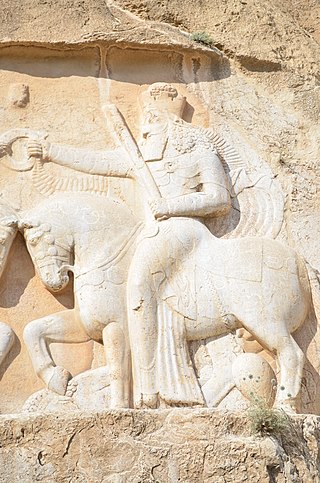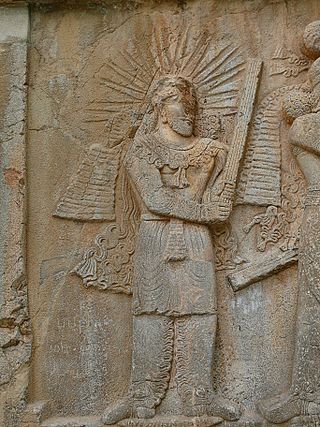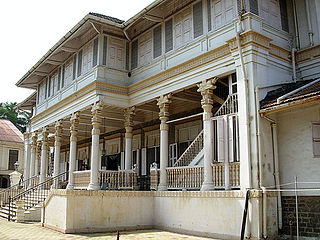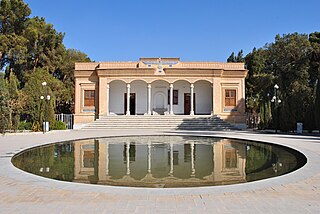Related Research Articles

Zoroastrianism is an Iranian religion and one of the world's oldest organized faiths, based on the teachings of the Iranian-speaking prophet Zoroaster. It has a dualistic cosmology of good and evil within the framework of a monotheistic ontology and an eschatology which predicts the ultimate conquest of evil by good. Zoroastrianism exalts an uncreated and benevolent deity of wisdom known as Ahura Mazda as its supreme being. Historically, the unique features of Zoroastrianism, such as its monotheism, messianism, belief in free will and judgement after death, conception of heaven, hell, angels, and demons, among other concepts, may have influenced other religious and philosophical systems, including the Abrahamic religions and Gnosticism, Northern Buddhism, and Greek philosophy.

Ahura Mazda, also known as Oromasdes, Ohrmazd, Ahuramazda, Hoormazd, Hormazd, Hormaz and Hurmuz, is the creator deity in Zoroastrianism. He is the first and most frequently invoked spirit in the Yasna. The literal meaning of the word Ahura is "lord", and that of Mazda is "wisdom".

Mithra commonly known as Mehr, is the Iranian deity of covenant, light, oath, justice and the sun. In addition to being the divinity of contracts, Mithra is also a judicial figure, an all-seeing protector of Truth, and the guardian of cattle, the harvest, and of the Waters.

Atar, Atash, or Azar is the Zoroastrian concept of holy fire, sometimes described in abstract terms as "burning and unburning fire" or "visible and invisible fire". It is considered to be the visible presence of Ahura Mazda and his Asha through the eponymous Yazata. The rituals for purifying a fire are performed 1,128 times a year.

A fire temple, Agiary, Atashkadeh, Atashgah (آتشگاه) or Dar-e Mehr is the place of worship for the followers of Zoroastrianism, the ancient religion of Iran (Persia). In the Zoroastrian religion, fire, together with clean water, are agents of ritual purity. Clean, white "ash for the purification ceremonies [is] regarded as the basis of ritual life", which "are essentially the rites proper to the tending of a domestic fire, for the temple [fire] is that of the hearth fire raised to a new solemnity". For, one "who sacrifices unto fire with fuel in his hand ..., is given happiness".

Vohu Manah is the Avestan language term for a Zoroastrian concept, generally translated as "Good Purpose", "Good Mind", or "Good Thought", referring to the good state of mind that enables an individual to accomplish their duties. Its Middle Persian equivalent, as attested in the Pahlavi script texts of Zoroastrian tradition, is 𐭥𐭤𐭥𐭬𐭭 Wahman, which is a borrowing of the Avestan language expression and has the same meaning, and which continues in New Persian as بهمن Bahman and variants. Manah is cognate with the Sanskrit word Manas suggesting some commonality between the ideas of the Gathas and those of the Rigveda. The opposite of Vohu Manah is akem manah or Aka Manah, "evil purpose" or "evil mind".

Yazata is the Avestan word for a Zoroastrian concept with a wide range of meanings but generally signifying a divinity. The term literally means "worthy of worship or veneration", and is thus, in this more general sense, also applied to certain healing plants, primordial creatures, the fravashis of the dead, and to certain prayers that are themselves considered holy. The yazatas collectively are "the good powers under Ahura Mazda", who is "the greatest of the yazatas".

Apas is the Avestan language term for "the waters", which, in its innumerable aggregate states, is represented by the Apas, the hypostases of the waters.

Zoroastrianism in Azerbaijan goes back to the first millennium BC or earlier and was the predominant religion of Greater Iran before the conversion to Islam.

Verethragna is an Indo-Iranian deity.
Udvada is a town situated in Pardi taluka in the Valsad district in the state of Gujarat, India. Udvada is a coastal town located around 24 km from the Valsad city. The Zoroastrian temple, Udvada Atash Behram is situated here.

Asha is a Zoroastrian concept with a complex and highly nuanced range of meaning. It is commonly summarized in accord with its contextual implications of 'truth' and 'right(eousness)', 'order' and 'right working'. For other connotations, see meaning below. It is of cardinal importance to Zoroastrian theology and doctrine. In the moral sphere, aṣ̌a/arta represents what has been called "the decisive confessional concept of Zoroastrianism". The opposite of Avestan aṣ̌a is 𐬛𐬭𐬎𐬘 druj, "deceit, falsehood".

The kushti also known as kosti, kusti and kustig is the sacred girdle worn by invested Zoroastrians around their waists. Along with the sedreh, the kushti is part of the ritual dress of the Zoroastrians.

Anahita is the Old Persian form of the name of an Iranian goddess and appears in complete and earlier form as Aredvi Sura Anahita, the Avestan name of an Indo-Iranian cosmological figure venerated as the divinity of "the Waters" (Aban) and hence associated with fertility, healing and wisdom. There is also a temple named Anahita in Iran. Aredvi Sura Anahita is Ardwisur Anahid or Nahid (ناهید) in Middle and Modern Persian, and Anahit in Armenian. An iconic shrine cult of Aredvi Sura Anahita was – together with other shrine cults – "introduced apparently in the 4th century BCE and lasted until it was suppressed in the wake of an iconoclastic movement under the Sassanids." The symbol of goddess Anahita is the Lotus flower. Lotus Festival is an Iranian festival that is held on the sixth day of July. Holding this festival at this time was probably based on the blooming of lotus flowers at the beginning of summer.
An Atash Behram is the highest grade of a fire that can be placed in a Zoroastrian fire temple as an eternal flame, the other two lower graded fires are Atash Adaran and below Adaran is the Atash Dadgah- these three grades signify the degree of reverence and dignity these are held in. The establishment and consecration of the Atash Behram fire is the most elaborate of all the grades of fire. It involves the gathering of 16 different types of fire, including fire by lightning, fire from a cremation pyre, fire from trades where a furnace is operated, and fires from the hearths as is also the case for the Atash Adaran. Each of the 16 fires is then subject to a purification ritual before it joins the others. A large team of priests are required for the purification and consecration ceremonies, which can take up to a year to complete.

The Iranshah Atash Behram, also known as the Udwada Atash Behram is a sacred fire housed in a temple in Udvada, Gujarat on the west coast of India. It is the first of the eight fire temples of the Zoroastrian religion in the country. The Atash Bahram, meaning "Victorious Fire", is the oldest fire temple in India, dated to the eighth century, and represents the historical cultural and religious links with Iran. The current temple housing the sacred fire was built in 1742 by Motlibai Wadia from Bombay. The temple structure, built spaciously, is well decorated and contains the Dasturji Kaiyoji Mirza hall and a museum. The main hall of the temple is accessed through a two-stage staircase. The temple attracts Zoroastrian pilgrims from all parts of India, Pakistan, and from around the world.

The Fire Temple of Yazd, also known as Yazd Atash Behram, is a Zoroastrian fire temple in Yazd, Yazd province, Iran. It enshrines the Atash Bahram, meaning “Victorious Fire”, dated to 470 AD. It is one of the nine Atash Bahrams, the only one of the highest grade fire in ancient Iran where Zoroastrians have practiced their religion since 400 BC; the other eight Atash Bahrams are in India. According to Aga Rustam Noshiravan Belivani, of Sharifabad, the Anjuman-i Nasiri opened the Yazd Atash Behram in the 1960s to non-Zoroastrian visitors.

Ancient Iranian religion or Iranian paganism, refers to the ancient beliefs and practices of the Iranian peoples before the rise of Zoroastrianism. The religion closest to it was the Historical Vedic religion that was practiced in the ancient Indian subcontinent. The major deities worshipped were Varuna and Mithra from Iran to Rome, but Agni was also worshipped, as names of kings and common public showing devotion to these three exist in most cases. But some sects, the precursors of the Magi, also worshipped Ahura Mazda, the chief of the Asuras. With the rise of Zoroaster and his new, reformatory religion; Assura Medha or Ahuramazda became the principle deities and Devas were relegated to the background. A lot of the attributes and commandments of Varuna, called Fahrana in Medean times, were later attributed to Ashura Medha by Zoroaster.
Xwedodah is a spiritually-influenced style of consanguine marriage assumed to have been historically practiced in Zoroastrianism before the Muslim conquest of Persia. Such marriages are recorded as having been inspired by Zoroastrian cosmogony and considered pious, though little academic and religious consensus has been established as to the extent of the practice of Xwedodah outside of the aristocracy and clergy of the Sasanian Empire. In modern Zoroastrianism it is near non-existent, having been noted to have disappeared as an extant practice by the 11th century AD.
Dastur Peshotanji Behramji Sanjana was an Indian scholar and Zoroastrian head-priest (Dastur). He was Principal of the Sir Jamshedji Jijibhoy Zartoshti (Zoroastrian) Madressa (seminary) in Bombay, and the Dastur (‘high-priest’) of the Wadia Atash Behram . Sanjana was one of the most learned high-priests and authorities on Pahlavi of his time. In 1904 a Festschrift was published in his honour with an introduction by Edward William West.
References
- ↑ Noshir H. Dadrawala (September 16, 2017). "Ardibehesht – The Embodiment of Truth, Righteousness And Divine Order". Parsi Times.
- ↑ Boyce, M. (2011) [1987]. "ĀTAŠ". Encyclopedia Iranica .
- ↑ "LacusCurtius • Strabo's Geography — Book XV Chapter 3".
- ↑ Mythology and Iranian culture، P 405 and 406